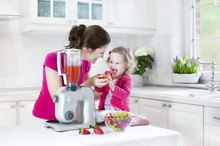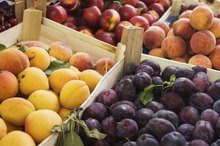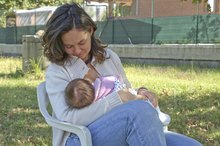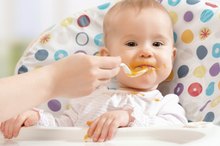What does fact checked mean?
At Healthfully, we strive to deliver objective content that is accurate and up-to-date. Our team periodically reviews articles in order to ensure content quality. The sources cited below consist of evidence from peer-reviewed journals, prominent medical organizations, academic associations, and government data.
The information contained on this site is for informational purposes only, and should not be used as a substitute for the advice of a professional health care provider. Please check with the appropriate physician regarding health questions and concerns. Although we strive to deliver accurate and up-to-date information, no guarantee to that effect is made.
List of Vitamin C Rich Foods for Babies
Vitamin C is one of the 13 essential vitamins your baby needs on a daily basis to support proper growth and development. Vitamin C is mainly found in fruits and vegetables. It's also found in your breast milk and formula. When the time comes to start introducing solid foods to your infant's diet, adding the right fruits and vegetables helps your baby get a proper intake of vitamin C.
Functions and Intake
Vitamin C is essential for proper wound healing. It aids in the adsorption of iron and calcium. It's necessary for healthy skin, bones and teeth. It also functions as an antioxidant and helps protect your cells and fatty acids from damage caused by free radicals. If your baby is not getting enough of vitamin C, it can lead to bleeding of the gums, dry skin, bruising and increased risk of infections. Your baby's daily vitamin C needs depend on her age. Infants 6 months or younger need 40 mg., while infants between 7 to 12 months need 50 mg. of vitamin C, according to the Linus Pauling Institute 1.
- Vitamin C is essential for proper wound healing.
- It also functions as an antioxidant and helps protect your cells and fatty acids from damage caused by free radicals.
Fruits and Juices
High-Fat, Non-Dairy Foods for Babies
Learn More
Many fruit juices are also good sources of the vitamin; recommended juices include raw orange juice, pineapple-grapefruit juice, cranberry juice, pink grapefruit juice and pineapple-orange juice. Make a delicious vitamin C-rich fruit puree with fresh fruits and juice. Alternately, chop fresh fruits into small pieces and give to your baby as finger food. The amount of food your baby eats increases with age; at first you might only get her to eat few spoonfuls of fruit puree. Introduce these foods slowly, while still providing most nutrition in the form of breast milk or formula.
- Many fruit juices are also good sources of the vitamin; recommended juices include raw orange juice, pineapple-grapefruit juice, cranberry juice, pink grapefruit juice and pineapple-orange juice.
- The amount of food your baby eats increases with age; at first you might only get her to eat few spoonfuls of fruit puree.
Vegetables
Vegetables are another excellent source of vitamin C. According to the USDA, vegetables that are high in vitamin C include:
- sweet red peppers
- sweet green peppers
- broccoli
- peas
- cauliflower
- kale
Serve vegetables by quickly steaming them and then pureeing with a little boiled water. Cool before serving; store additional servings in the freezer in small plastic containers. Add fruits or cooked pasta to make more nutritious food for your solids eater.
Considerations
Vitamins for a 2-Year-Old
Learn More
Many commercially prepared baby foods made with fruits and vegetables also contain vitamin C. Check the food labels to find out the vitamin content. Vitamin C is water-soluble; it's easily destroyed or removed during cooking, according to the Colorado State University Extension. Avoid cooking for long periods of time. Steam, rather than boil, to help preserve vitamin C. Vitamin C can cause toxicity when consumed in high doses. The Linus Pauling Institute reports that the only source of vitamin C for babies younger than 12 months should be in the form of foods and drinks. The upper intake limit for children between 1 and 3 years old is 400 mg. per day.
- Many commercially prepared baby foods made with fruits and vegetables also contain vitamin C. Check the food labels to find out the vitamin content.
- The Linus Pauling Institute reports that the only source of vitamin C for babies younger than 12 months should be in the form of foods and drinks.
Related Articles
References
- Linus Pauling Institute Oregon State University; Vitamin C; Jane Higdon; January 2006
- Holick MF, Gordon CM. Patient Guide to Vitamin D Deficiency. The Journal of Clinical Endocrinology & Metabolism. 2011;96(7):1-2. doi:10.1210/jcem.96.7.zeg33a
- Sunyecz JA. The use of calcium and vitamin D in the management of osteoporosis. Ther Clin Risk Manag. 2008;4(4):827-836. doi:10.2147/tcrm.s3552
- Giovannucci E, Liu Y, Hollis BW, Rimm EB. 25-hydroxyvitamin D and risk of myocardial infarction in men: a prospective study. Arch Intern Med. 2008;168(11):1174-1180. doi:10.1001/archinte.168.11.1174
- Gorham ED, Garland CF, Garland FC, et al. Optimal vitamin D status for colorectal cancer prevention: a quantitative meta analysis. Am J Prev Med. 2007;32(3):210-216. doi:10.1016/j.amepre.2006.11.004
- Lappe JM, Travers-Gustafson D, Davies KM, Recker RR, Heaney RP. Vitamin D and calcium supplementation reduces cancer risk: results of a randomized trial. The American Journal of Clinical Nutrition. 2007;85(6):1586-1591. doi:10.1093/ajcn/85.6.1586
- Prentice RL, Pettinger MB, Jackson RD, et al. Health risks and benefits from calcium and vitamin D supplementation: Women’s Health Initiative clinical trial and cohort study. Osteoporos Int. 2013;24(2):567-580. doi:10.1007/s00198-012-2224-2
- Urashima M, Segawa T, Okazaki M, Kurihara M, Wada Y, Ida H. Randomized trial of vitamin D supplementation to prevent seasonal influenza A in schoolchildren. Am J Clin Nutr. 2010;91(5):1255-1260. doi:10.3945/ajcn.2009.29094
- Salehpour A, Hosseinpanah F, Shidfar F, et al. A 12-week double-blind randomized clinical trial of vitamin D₃ supplementation on body fat mass in healthy overweight and obese women. Nutr J. 2012;11:78. doi:10.1186/1475-2891-11-78
- Carrillo AE, Flynn MG, Pinkston C, et al. Impact of vitamin D supplementation during a resistance training intervention on body composition, muscle function, and glucose tolerance in overweight and obese adults. Clin Nutr. 2013;32(3):375-381. doi:10.1016/j.clnu.2012.08.014
- Marcinowska-Suchowierska E, Kupisz-Urbańska M, Łukaszkiewicz J, Płudowski P, Jones G. Vitamin D Toxicity-A Clinical Perspective. Front Endocrinol. 2018;9:550. doi:10.3389/fendo.2018.00550
- Ross AC, Manson JE, Abrams SA, et al. The 2011 report on dietary reference intakes for calcium and vitamin D from the Institute of Medicine: what clinicians need to know. J Clin Endocrinol Metab. 2011;96(1):53-58. doi:10.1210/jc.2010-2704
- Bouillon R, Van Schoor NM, Gielen E, et al. Optimal vitamin D status: a critical analysis on the basis of evidence-based medicine. J Clin Endocrinol Metab. 2013;98(8):E1283-E1304. doi:10.1210/jc.2013-1195
- American Academy of Dermatology. Position Statement of Vitamin D. 2010.
- Taksler GB, Cutler DM, Giovannucci E, Keating NL. Vitamin D deficiency in minority populations. Public Health Nutr. 2015;18(3):379-391. doi:10.1017/S1368980014000457
- Holick MF, Binkley NC, Bischoff-Ferrari HA, et al. Evaluation, treatment, and prevention of vitamin D deficiency: an Endocrine Society clinical practice guideline. J Clin Endocrinol Metab. 2011;96(7):1911-1930. doi:10.1210/jc.2011-0385
- Cannell JJ, Vieth R, Umhau JC, et al. Epidemic Influenza and Vitamin D. Epidemiol Infect. 2006; 134:1129-40.
- Carrillo AE1, Flynn MG, Pinkston C, Markofski MM, Jiang Y, Donkin SS, Teegarden D. Impact of Vitamin D Supplementation During a Resistance Training Intervention on Body Composition, Muscle Function, and Glucose Tolerance in Overweight and Obese Adults. Clin Nutr. 2013 Jun;32(3):375-81. doi: 10.1016/j.clnu.2012.08.014. Epub 2012 Aug 31.
- Ginde AA, Mansbach JM, Camargo CA, Jr. Association Between Serum 25-Hydroxyvitamin D Level and Upper Respiratory Tract Infection in the Third National Health and Nutrition Examination Survey. Arch Intern Med. 2009; 169:384-90.
- Giovannucci E, Liu Y, Hollis BW, Rimm EB. 25-hydroxyvitamin D and Risk of Myocardial Infarction in Men: a Prospective Study. Arch Intern Med. 2008; 168:1174-80.
- Gorham ED, Garland CF, Garland FC, Grant WB, Mohr SB, Lipkin M, Newmark HL, Giovannucci E, Wei M, Holick MF. Optimal Vitamin D Status for Colorectal Cancer Prevention: a Quantitative Meta-analysis. Am J Prev Med. 2007 Mar;32(3):210-6.
- Heaney, Robert P. “The Vitamin D Requirement in Health and Disease.” The Journal of Steroid Biochemistry & Molecular Biology 97 (2005):13-9.
- Holick MF. Vitamin D. In: Shils M, Olson J, Shike M, Ross AC, ed. Modern Nutrition in Health and Disease, 9th ed. Baltimore: Williams and Wilkins, 1999.
- National Institutes of Health Office of Dietary Supplements. Vitamin D: Dietary Supplement Fact Sheet. University of Ottawa Evidence-based Practice Center. Effectiveness and Safety of Vitamin D in Relation to Bone Health. Agency for Healthcare Research and Quality. Aug 2007: 07-E013.
- Salehpour A1, Hosseinpanah F, Shidfar F, Vafa M, Razaghi M, Dehghani S, Hoshiarrad A, Gohari M. A 12-week Double-blind Randomized Clinical Trial of Vitamin D₃ Supplementation on Body Fat Mass in Healthy Overweight and Obese Women. Nutr J. 2012 Sep 22;11:78. doi: 10.1186/1475-2891-11-78.
- Urashima M, Segawa T, Okazaki M, Kurihara M, Wada Y, Ida H. Randomized Trial of Vitamin D Supplementation to Prevent Seasonal Influenza A in Schoolchildren. Am J Clin Nutr. 2010 91:1255-60. Epub 2010 Mar 10.
- Wilkins, Consuelo H. and Yvette I. Sheline, et al. “Vitamin D Deficiency Is Associated with Low Mood and Worse Cognitive Performance in Older Adults.” American Journal of Geriatric Psychiatry 14 (2006): 1032-40.
Writer Bio
Maria Hoven is a health and fitness expert with over 10 years of expertise in medical research. She began writing professionally in 2004 and has written for several websites including Wound Care Centers and healthnews.org. Hoven is earning a Doctor of Philosophy in cell and molecular biology from the University of Nevada, Reno.









